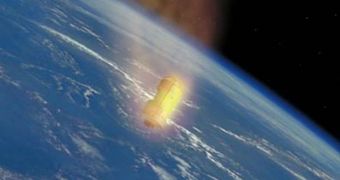The first of a new series of Japanese unmanned cargo spacecraft has recently concluded its first test flight to the International Space Station in total success. The H-2 Transfer Vehicle (HTV) undocked from the orbital lab on Friday, and began its atmospheric reentry on Sunday, when it burnt up high above the Pacific Ocean. The capsule, which was used to carry four and a half tons of cargo to the station, was filled with garbage and other residues from the facility as it began its descent, Space reports.
According to the Japan Aerospace Exploration Agency (JAXA) – the official operator of the new, 33-foot-long spacecraft) –, the HTV began to roll through the atmosphere at around 2126 GMT (4:26 pm EST), in the air just above the coast of New Zealand. During the reentry maneuvers, the cargo ship had to fire its thrusters three times, so as to reduce its speed by 199 miles per hour. This allowed it to slow down sufficiently to alter its orbit, and set it on a course to the upper atmosphere.
At about 2101 GMT (4:01 pm EST), mission controllers marked the end of the third and final engine firing. The event took place as the unmanned cargo capsule flew above the southern half of Japan. Officials at JAXA believe that, even though most of the HTV burnt up high in the air, some pieces of it might have reached the surface of the ocean. They believe that the craft's propellant tanks are the most likely to have survived the scorching temperatures of the atmospheric reentry. The agency added that the area where pieces of debris could have hit spanned a rectangle between New Zealand and South America.
“Most of the vehicle components are expected to be destroyed and burned out encountering the aerodynamic heating during the re-entry, but some of the debris is estimated to survive and fall into the South Pacific Ocean,” an official statement from JAXA says. The first mission of the HTV began on September 11, as the spacecraft took off from the beautiful Tanegashima Island spaceport, on the southern coast of Japan. The capsule spent 52 days in space, and was captured and docked to the station on September 17, when it came close enough to the lab for NASA astronaut Nicole Stott to use the station's robotic arm to capture it.
In the future, JAXA plans to construct about six other HTVs, which are scheduled to fly about once per year until 2016. The move is expected to ease some of the pressure that countries involved in the ISS will feel after the United States retire their shuttle fleet. By 2016, the replacement vehicles for Discovery, Atlantis and Endeavor, the ARES I rocket and the Orion Crew Exploration Vehicle are scheduled to be completed. The next HTV flight will most likely take place at the end of 2010.

 14 DAY TRIAL //
14 DAY TRIAL //